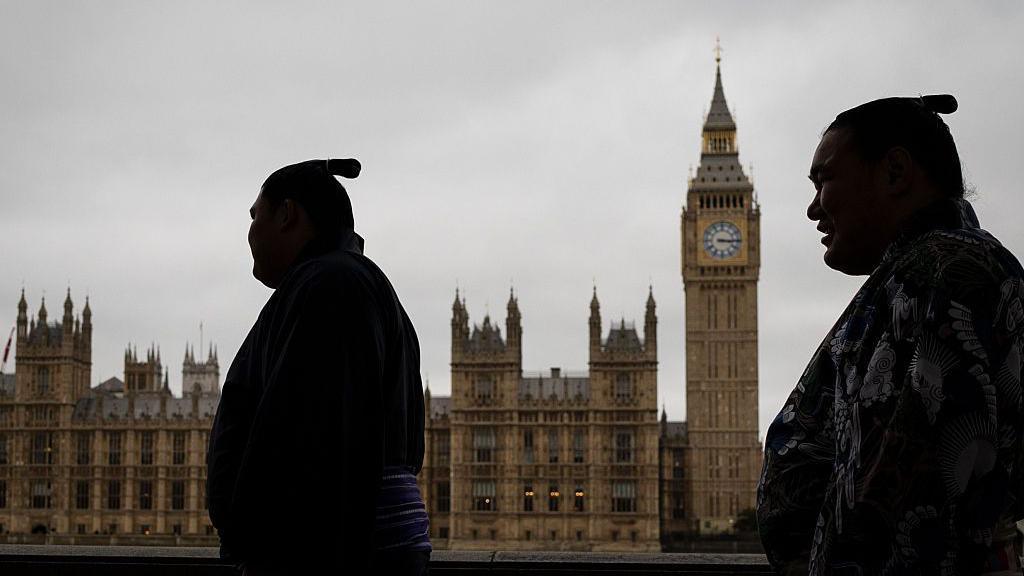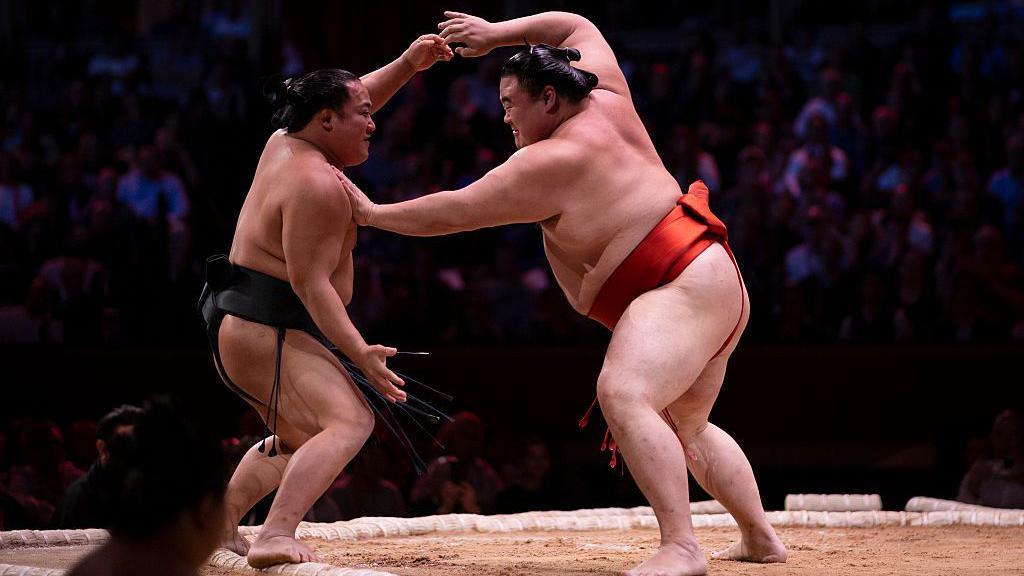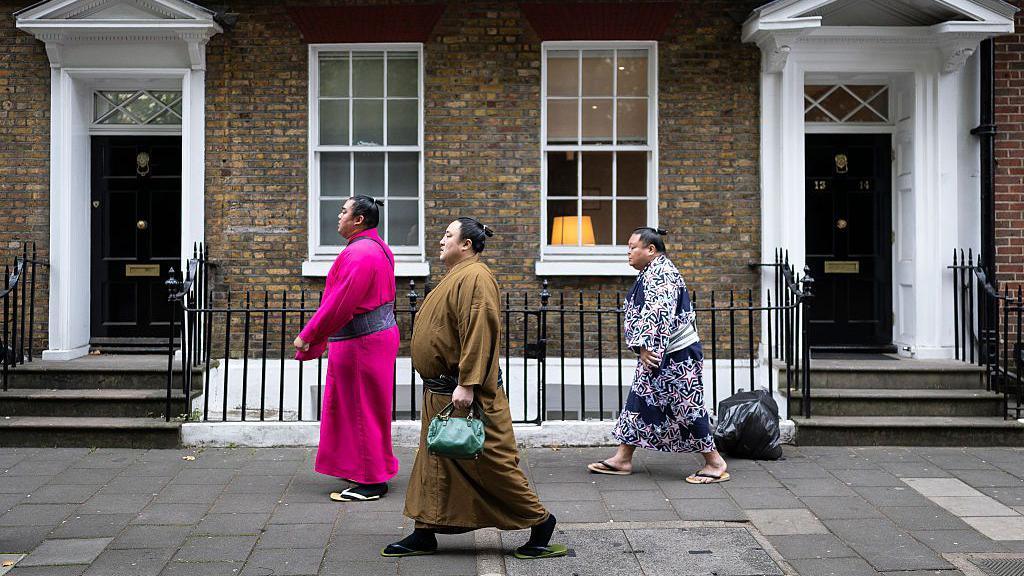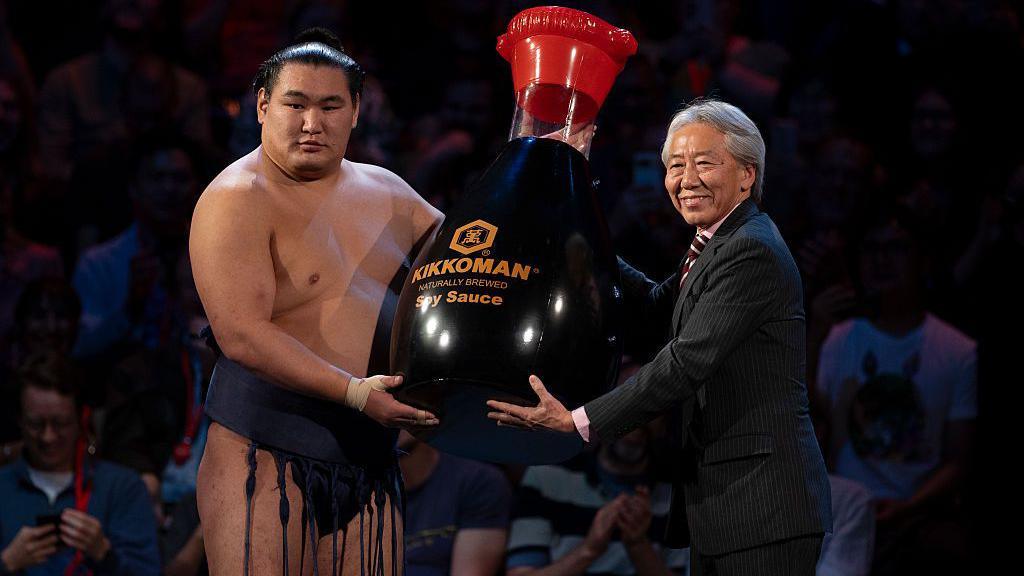How five days of sumo 'charmed' Britain

There are only two active yokozuna, the highest rank of sumo wrestlers - Onosato Daiki and Hoshoryu Tomokatsu
- Published
Why did the sumo wrestler cross the road?
To recreate the iconic cover of The Beatles' Abbey Road album, of course - just one of the many times the wrestlers, or rikishi, have gone viral over the past week - in between bouts at the Royal Albert Hall in London.
For five days, sumo fever took over Kensington as the Grand Sumo Tournament came to the UK for the first time in more than three decades.
For the devoted, ever-growing community of fans who mostly follow the sport online, the tournament represented a rare opportunity to catch the action in person, since the six annual honbasho events - which decide wrestling rankings - seldom take place outside of Japan.
But the rikishi brought plenty of excitement to the uninitiated, too, with former England prop Joe Marler calling it an "incredible spectacle".

Though rich with detail, the aim of the game is enticingly simple - make your opponent touch the ground with any part of his body which isn't the sole of his foot, or push him out of the ring, or dohyo, altogether.
Rikishi train intensely from a young age in order to master the precise rituals and 82 different winning techniques, or kimarite, but it was through their adventures outside of the dohyo that they stole the hearts of old and new British fans.
Because the 40 rikishi who travelled to compete in London crammed plenty of quintessentially British traditions into their visit.
Accustomed to taking on board up to 10,000 calories per day in pursuit of their ultimate competition weight, in London they swapped their usual high-protein chankonabe stew for fish and chips and pints of Guinness in between tours of Harrods and photo opportunities outside the Houses of Parliament.
Wrestlers were seen visiting Platform 9 3/4 at Kings Cross, made famous by the Harry Potter series, and some even made it as far as Stonehenge in Wiltshire.
Most-loved, though, were the photos snapped of the huge frames of the rikishi getting around the capital in black cabs, red buses - and even by bike., external

But back at the Royal Albert Hall, among the sporting highlights of the unique spectacle were the magnificent kainahineri - a two-handed arm twist down, external - with which 21-year-old Ukrainian Aonishiki Arata defeated Ura Kazuki, and the pause in play instructed by the referee, or gyoji, who intervened to spare Ura's blushes in front of a capacity crowd as his loose loincloth threatened to come off altogether., external
Accommodating the rikishi hasn't been straightforward, according to Matthew Todd, the Royal Albert Hall's director of programming, who told the Guardian, external that the venue "actually had to source and buy new chairs which can take up to 200kg in weight", as well as reinforce the toilets.
After five days of slapping, pushing, and purifying rituals, the contest was won by Mongolia's Hoshoryu Tomokatsu, who went home with a jumbo Hello Kitty plush and a giant bottle of soy sauce - as well as the glory.

Hiroshi Suzuki, the Japanese ambassador to the UK, said the wrestlers had "charmed the British people", while chairman of the British Sumo Federation, Steve Pateman, told BBC Radio 5 Live the Royal Albert Hall was "probably the greatest venue for sumo outside of Japan".
"It has been the greatest sporting spectacular of the decade without a doubt," added Pateman, who won a bronze medal at the World Sumo Championships in 1993.
"There's been a few little problems in Japan, with heckling among the audience, but [grand champion] Onosato [Daiki] was really complimentary about the British. And the real winners here this weekend were the British people and the rikishi.
"They mixed with the public, the people loved them and the rikishi loved the people. What a fabulous five days."
All 40 rikishi participated in the closing ceremony on Sunday, with the tournament's final remarks left to Japanese yokozuna Onasato Daiki.
"London is great. See you again."
Tournament left fans old and new wanting more - analysis
Sumo's global appeal has grown a lot in recent years, and for many European fans this was the first time seeing it live and a unique occasion to meet fellow sumo-lovers.
In London enthusiasts had a kind of access to wrestlers that they likely wouldn't have in Japan - hundreds of people waited for them to leave the arena every night for a selfie or an autograph.
Each day the audience was fascinated by the many rituals and traditions on display, from salt throwing to ring-entering ceremonies, and participated enthusiastically when prompted to shout at every yokozuna foot stomp.
There were stare-downs, false starts, belts almost coming loose, and leg lifts that left everyone in awe.
The Grand Sumo Tournament in London felt like a memorable event, and it certainly left old and new fans hungry for more.